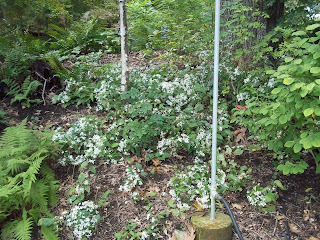This season I decided to take my first crack at a few of the hybrid ideas I've had bouncing around in my head for quite some time now... technically my second crack I guess. I actually tried last summer, but the parent plants I started got accidentally trampled to peices before I could do anything with them, so I've discounted it as an actual attempt. Needless to say I'm hoping this season will be slightly more successfull.
For anyone who isn't familiar with
Laburnocytisus or
Chitalpa, I mentioned them purely to establish a baseline of weirdness to demonstrate that my ideas for hybrids aren't completely implausible. Weirder stuff has definitely happened.
First on the to do list:
Apios americana x Vigna caracalla (aka Apogna)

Other than for pure entertainment purposes, what I was hoping to accomplish with this cross was to take a much under-appreciated (both horticulturally and agriculturally), but somewhat aggressive native perennial vine
Apios americana, and cross it with what at least looks to be a closely related, but much showier tropical perennial cousin,
Vigna caracalla to produce a (hopefully somewhat hardy) still showy and better behaved plant that will hopefully allow the larger horticulturally consuming masses to begin to appreciate
A. americana. For whatever reason it seems that in ornamental horticulture sometimes it takes a novelty hybrid to highlight the understated virtues of one, or both of the parents. While there is no scientific basis other than belonging to the same family (Fabaceae) that would indicate that these two could produce fertile offspring, the visual similarities are undeniable and enough indication for me. Hopefully I'm right.

Second on the to do list.... and one I am particularly excited about trying:
Passiflora incarnata x Passiflora lutea

The simple motivation behind this cross was to retain the majority of the characteristics of
P. incarnata, but improve winter hardiness.
P. incarnata (as far as I'm concerned) has no faults other than being tempermental in colder usda zones (5 and 6).
P. lutea on the other hand, while certainly not as showy, is more realiably hardy. Ironically, I feel the previous potential intergeneric hybrid (
Apios americana x
Vigna caracalla) is more likely to be a success, despite the fact that all passion flowers belong to the same genus (Passiflora). In this case
P. incarnata and
P. lutea inhabit a similar range, and the fact that there has not been any record of naturally occurring hybrids between the two species is not encouraging, but I will try none the less. Additionally, aside from the fact that it could just not be possible, I will have to locate plant material of both species from the northern extent of their ranges, ensuring that I'm at least starting out with the maximum possible cold adapted genetic material.
Third on the to do list:
(
Rubus arcticus x
Rubus flagellaris)

I have always been happy to find Dewberry (
R. flagellaris) flowers poking up through the grass of an abondoned feild or at the edges of a roadway. The flowers always reminded me a bit of anemones in their delicate character. Unfortunately, the plant as a whole is anything but delicate, and has always been a bit too wide rambling, aggresive, and overly adaptable to have warranted cultivation, even though the fruits are edible and comparable to other wild-type blackberries. To temper and restrain the plant, and make it more ameable to both ornamental and agricultural cultivation,
R. arcticus seemed like a perfect partner. Fairly restrained in both habit and form, soft muave-magenta (can magenta be soft?) flowers, and yummy fruit, Arctic Raspberry (
Rubus arcticus) couldn't have been more complementary. Its only downside is that it is obviously not very heat tolerant, but I'm hoping the contributions by
R. flagellaris will take care of that problem. Unfortunately, I will only be able to locate and obtain
R. arcticus in preparation for next year, as both plants are currently in flower, and I only have have access to
R. flagellaris. Ignoring the fact that the actual pollination won't happen till next year, I'm really excited to see the qualities of the first generation offspring. Between fruit, flower, and groundcover potential, I'm hoping at least one of the children will be a star.
However, even if my all my efforts prove fruitful (get it?), the storage, stratification, treatment, and (with a lot of luck) successful germination of any viable seed will be the most difficult part. Lucky for me (and now for you too!) I know of 2 great sources that will hopefully help me out: William Cullina's
Wildflowers: A Guide to Growing and Propagating Native Flowers of North America and Joseph Tychonievich's
Plant Breeding for the Home Gardener: How to Create Unique Vegetables and Flowers.
Wish me luck and happy hybridizing!!!!
















































